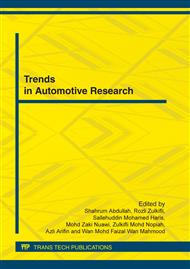p.197
p.202
p.209
p.214
p.219
p.224
p.232
p.237
p.242
Elevated Temperature Fatigue Fracture Behaviour of Aluminium Alloy Subjected to Spectrum Loadings
Abstract:
This paper discusses the fatigue fracture behaviour of aluminium alloy AA6061-T6 under spectrum loadings at room and elevated temperatures. The load sequence can have a very significant effect in fatigue lives and normally the fatigue strength of material decrease with increasing temperature. In this study, variable amplitude loading (VAL) signal was obtained from the engine mount bracket of an automobile in a normal driving condition. Constant amplitude loading (CAL), high to low and low to high spectrum loadings were then derived from the VAL obtained from the data capturing process to study the fatigue behaviour that subjected to spectrum loadings at the room and elevated temperatures. The fatigue tests were performed according to an ASTM E466 standard using a servo-hydraulic fatigue testing machine. Fatigue fracture surfaces were then sectioned and inspected by employing a high magnification microscope. Results indicated that fracture surface behaviours of specimens were influenced significantly by the load sequence and temperatures, which can be related to the fatigue lives of aluminium alloy under spectrum loadings.
Info:
Periodical:
Pages:
219-223
Citation:
Online since:
April 2012
Authors:
Keywords:
Price:
Сopyright:
© 2012 Trans Tech Publications Ltd. All Rights Reserved
Share:
Citation:


